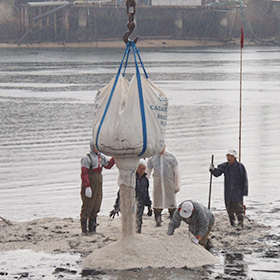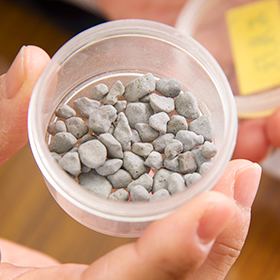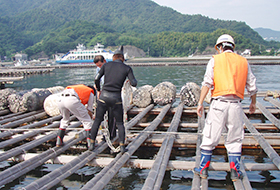 |
| |

|
| |
|
Developing practical techniques aimed at restoration of the basin ecosystem
and environment.
|
| |
 |
|
Through research into the basin system, Professor Tamiji
Yamamoto has analyzed material cycles and devised many effective measures to
improve deteriorated conditions of aquatic environments so far. His research
is not confined to conventional research just understanding the present
situations, but is characterized by developing remediation technologies for
problem-resolution which is linking to contributions to the local
community.
“The term ‘basin system’ refers to the area through which water flows from
mountains through rivers and flows into the sea. Since the water carries a
variety of substances before reaching the sea, river mouth areas tends to
most contaminated. Particularly, organic matter accumulates on the coastal
seabed forming organically enriched sediments” explains Professor Yamamoto.
|
|
| |
What is the present state of the ocean? According to the
professor, although the seawater has been getting clear, bottom sediments
are contaminated with organic matter. This is thanks to the efforts over
more than three decades continued by the Ministry of the Environment to
regulate the total loads of pollutants. Water pollution, red tide caused by
eutrophication, and other issues that were once sources of great concern
have now largely been remedied, allowing us to bring back the beautiful sea.
Nevertheless, Professor Yamamoto points out that there are still other
problems to be addressed.
“It is true that the seawater has become clean, but which means that less
food available for marine organisms, making them difficult to grow. This
situation must be improved.”
|
|
 |
Toward this end, Professor Yamamoto has taken two
approaches. One is to improve the quality of the organically enriched
sediments, and the other is to supplement insufficient nutrients in the
sea.
He says, “The sediments are inherently difficult to pass through air, and a
highly toxic substance called ‘hydrogen sulfide’ can be generated in the
sediments under an anaerobic condition. Hydrogen sulfide smells like rotten
eggs, which you can often perceive around places such as gutters or ditches.
Due to this fatal substance, worms, bivalves, and other living organisms
that are served as foods for fish have become unable to live in the sea
bottom. For this reason, I first wanted to remediate organically enriched
sediments.” |
|
| |
|
Utilizing industrial byproducts, by recycling oyster shells, slag, and coal
ash
|
| |
 |
|
Thus, Professor Yamamoto developed various materials for
sediment improvement.
One of them is oyster shells. Hiroshima Prefecture is producing the largest
amount of oysters in Japan. When crushed oyster shells are dried with hot
air at a temperature of 400℃ or so, calcium carbonate of the shell surface
turns into calcium oxide. One you plow the calcium oxide-bearing materials
into the tidal flat sediments, hydrogen sulfide will be neutralized.
Another improvement material uses coal ash, which is a powdered byproduct
produced from coal-fueled power plants. By adding cement, coal ash is
granulated. We can apply the granulated coal ash to remediate sediments. The
granulated coal ash has many minute spaces/pores between the grains.
Accordingly, if mixed with granulated coal ash, sediments are oxidized due
to the large amount of air contained in the ash, soon suppressing the level
of hydrogen sulfide as well. Professor Yamamoto says, “Granulated coal ash’s
ability to reduce the concentration of hydrogen sulfide is about ten times
higher than that of oyster shells.” |
|
| |
Professor Yamamoto also developed remediation materials using
several types of slag, a byproduct from the steelmaking process. One of
these is blast-furnace slag, which is remnant after iron ore is burned at a
high temperature of 1,500℃. Though looking like sand, blast-furnace slag has
the property of hardening with water. Another example is dephosphorization
slag, produced by removing phosphorus from iron. Dephosphorization slag is
generated when high purity steel is made from iron. For either type of slag,
the iron content plays an important role. Iron ions dissolve in water and
combine with hydrogen sulfide, so as to produce iron sulfide. As a result,
the material is able to reduce the level of hydrogen sulfide.
All the sediment improvement materials mentioned above are in line with the
move to promote more effective use of recycled byproducts that are produced
in large quantity during industrial processes, based on the Basic Law for
Establishing a Recycling-based Society enacted in 2000. For their usefulness
and ecological features, these materials have attracted much attention from
many companies, local governments, and national agencies and ministries.
|
|
 |
|
| |
|
Hoping to develop more remediation materials that will be further embraced
by society: the next theme is underground spring water
|
| |
|



According to research themes, study locations vary greatly, including
mountains, lakes, the ocean, and ports. His team pursues aggressive
research to explore the mysteries of nature.
|
|
Professor Yamamoto says, “Now we are working to develop another
material for sediment improvement.” This material consists of iron powder,
coal ash, and citric acid. Its main component, iron, is reliable in
controlling hydrogen sulfide, and coal ash contains nitrogen. By combining
these two components, this material can not only reduce the level of
hydrogen sulfide, but also supply nitrogen and phosphorus, which comprise
major nutrients which nourish aquatic living things. This is exactly a novel
material designed to remediate organically enriched sediments while
supplementing insufficient nutrients in the sea, so as to increase the
amount of food for marine organisms. Citric acid is a chelating agent to
dissolve iron in water.
“In fact, some people have a feeling of resistance about slag, because it
carries a negative image as industrial waste. However, this newly developed
material is free from such worries. Our experiment conducted in the tidal
flats in Onomichi proved that in the site where this material is mixed with
the sediments showed nine times magnitudes higher in the number of Japanese
short-necked clams (Asari) compared to the number in the site without mixing
this material. I myself was a little surprised by the experimental results.”
He added that, based on these results, this research project was
subsequently granted research funds provided by the Ministry of Agriculture,
Forestry and Fisheries, and that his team is scheduled to implement a series
of experiments in earnest in this and the next academic years.
“I am greatly delighted that my research is capable of making a contribution
to the local community. Since various countries around the world share
similar environmental problems, I expect that our research findings will
eventually find broader applications,” he says with a smile.
Professor Yamamoto also stated that he will place further emphasis on
research into underground spring water on the sea bottom. “Regarding
so-called underground spring water, we still do not clearly understand the
flow rate volume and kinds of water quality there, regarding the contents of
nitrogen, phosphorus, iron, etc. We aren’t sure yet whether the underground
spring water may impose a burden on the sea, or if it may help in cleaning
seawater, so I want to conduct more detailed investigations.” |
|
| |
| Tamiji Yamamoto |
|
Professor
Laboratory of Aquatic Ecosystem Management
Department of Environmental Dynamics and Management
April 1, 2004 – present Professor, Hiroshima University
August 1, 1995 – March 31, 2004 Associate Professor, Hiroshima
University
April 1, 1991 - July 31, 1995 Assistant Professor, Hiroshima
University
April 1, 1985 - March 31, 1991 Scientist, Aichi Fisheries
Institute
April 1, 1983 - March 31, 1985 Research Fellow, Japan Society for the
Promotion of Science
Posted on Jun 2, 2014
|
| |









